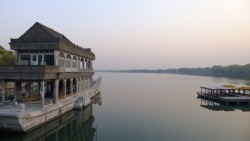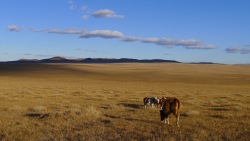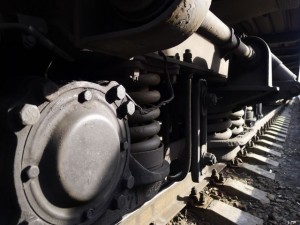Mongolia is a vast area of nothingness and traveling on your own is not easy around here, especially in non-friendly environment of Gobi. After a few days of unsuccessful attempts of organizing a trip on my own, I ended up meeting some cool people and we booked an all expenses-paid tour. Dani from the UK, Dev from California, Zhenya from Moscow, Helena from a small village in Sweden and myself. All solo-travellers, who had never met before, we formed an excellent diverse team. Most of the trip consisted of driving through the empty desert for hours, breathing dust, having a lunch break and a quick sight-seeing in the evening (if there was any) followed by Ristiseiska, simplified Canasta and Shithead after the sunset. Rinse and repeat the same procedure the next day.
The closer to Gobi you are, the emptier it becomes. Steppes with scarce vegetation turn into deserts with even less signs of life. Rare trees, low-growing weed, rocky hills, birds and lone-standing gers is all what you encounter on your way through Gobi. Infrastructure is almost nonexistent as well as trails of human activity. You may drive for hundreds kilometers without seeing any signs of civilization anywhere. Paved roads end around 20 km outside of Ulan Bator and it is a freestyle ride after that. On the other hand, the entire desert area is full of improvised roads, which are actually much better than battered roads around Ulan Bator thanks to the flat surface. In some places the landscape is so flat, that it is almost like a giant natural airfield. Interestingly enough, jeeps and land cruisers are not a good choice for getting around in Mongolia, but Soviet-made vans are. As a Russian saying goes: the fancier jeep you have got, the longer distance you will have to walk to get a tractor. One advantage of Soviet technology is its simplicity. They do break down, but you can fix them on the go, especially due the abundance of spare parts.
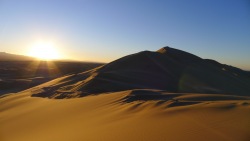
As it turned out there is not much to see in the desert apart from this vast empty wilderness. There are a couple of rare natural sights and rock formations here and there in Gobi, but that is about it. Nonetheless this vast nothingness and majestic silence are exactly the reasons why you come here. After you spend hours in the van staring at the emptiness and finally get a chance to see one of the sights, it is truly magical. The Flaming Rocks (a small brother to Red Rock in Australia), the Great Sand Dune, Ice Valley and Salt Lake, all are magnificent and so vastly different to each other. It was an interesting experience to go from warm sand dunes to ice-laden mountains, not so different to Lapland in a single day. Night sky was mind-blowing too, thanks to lack of clouds and light pollution. I think this was the first time I saw Milky Way in its fullest potential – not only the stars, but all this whitish star mist too. A fabulous view, only if it was a little bit warmer to make stargazing more pleasant. Shame that I have figured out how to set up super long exposure in my camera only much later, so no pictures of the night sky. Weather was excellent, although a little bit cold. This is in fact not so rare for Mongolia – it is called the Land of the Blue Sky for the reason after all.
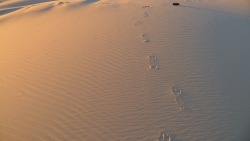
Rare villages we encountered on the way reminded me of towns you see in Western movies: scattered lone buildings, bright sunshine, lots of dust and sand and even tumbleweed making its way through the desert. A perfect setting for a Mongolian western if there will be ever one. We spent every night in a ger, a traditional Mongolian tent on steroids, equipped with furniture, a crappy stove used for both cooking and heating and kitsch wall decorations. Fancier gers (not tourist ones, though) have even solar power and satellite TV – talk about technological progress! While this type of accommodation wass certainly novel and exotic to me, it was full of shortcomings. A little bit too short beds, poor thermal insulation and a crappy stove that does not retain heat made nights somewhat restless. Plus the lack of coal in most places and use of camel shit instead made things a bit chilly. After going to sleep, I woke up several hours later because of the cold. Brrr.. Having a sleeping bag and an extra blanket did not always help. Interestingly enough Mongols have a different standards of what is cold and what is warm and the conditions that were cold to us, did not seem to bother them at all. Another interesting cultural aspect that you do not take off shoes or outdoor clothes in a ger, so lines between the indoors and outdoors are blurred in a Mongolian mindset. Needless to say that the hygiene standards are a bit different around here.
Seven days was enough to get a taste of Mongolia’s wilderness, even with the hectic schedule (our van broke down on the first day, which resulted in one lost day). I am glad I visited Gobi now, as it is apparently unbearable in summer with temperatures rising up to +45C. Apart from those freezing moments at night and bad traditional Mongolian food (in a nutshell: meat with pasta, no spices), it was a blast.
